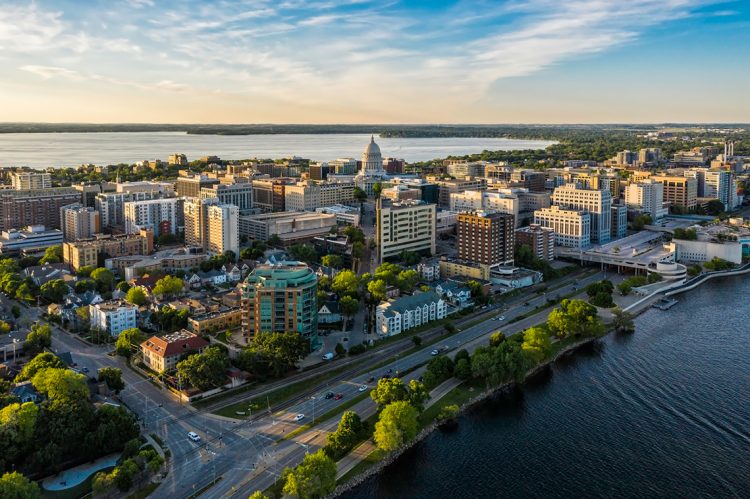It’s become less of a debate and more of a fact recently that having a good work/life balance is one of the pillars of mental health and sustainable productivity, not only among individuals, but among companies. But balancing work and life differs from person to person as much as it differs from place to place.
CoworkingCafe’s latest report looked at 100 cities with at least 200,000 residents and assigned scores based on mental health metrics, such as the amount of green space and recreational amenities; air quality; and, of course, work hours. It also scored the cities based on income, affordability, remote working prevalence, commute times and how many residents had health insurance. The scores were combined and weighted to create an overall work/life balance index, with a heavy focus on mental health.
The report found that midsized Midwestern cities dominated the top for work/life balance and mental health with seven cities in the top ten. Alos, the top three cities were swept away by the Midwest: Minneapolis, Minnesota; Madison, Wisconsin and Lincoln, Nebraska.
Key highlights:
- Minneapolis excelled with the average work week coming in just below 38 hours. The city also had one of the highest coverages of health insurance with 94% of the population having either private or public health insurance. The $70,099 median household income was just slightly above the average for similar-sized cities, but there’s still a favorable cost of living. Plus, 16% of the working population are in remote jobs.
- Madison aced the mental health score, thanks to the shortest average work week at 36.6 hours. Likewise, its 96% coverage for health insurance was a top-five position on its own, while the density of recreational amenities was also exactly twice the average. The city also ranked in the top 10 by commute score with a 19.6-minute average commute time, and was in the top third when ranked by affordability and remote work.
- Lincoln had outstanding placements for mental health, affordability and commute. Notably, Lincoln had the fourth-best air quality among the largest cities. But, with just over 37 hours worked per week, on average, and plenty of sports courts and gyms, the city also landed several top-10 ranks for the individual metrics. And the lower prices also gave Lincoln salaries the 11th-strongest buying power overall.
- Four more Midwestern cities in the top 10: Des Moines, IA followed a similar score distribution to Lincoln’s pattern, and St. Paul, MN stood out as the second-best city overall for mental health. At the same time, Columbus, OH and Omaha, NE hammered home the Midwestern dominance.
- Omaha owed its placement in the top 10 mostly to a highly favorable income-to-costs ratio on top of its short, 19.3-minute average commute time. Finally, while Columbus also ranked consistently above average for all work/life balance metrics, it’s worth noting that it’s also the largest city in the top 20, by far, with just shy of 900,000 residents.
- The Southeast was also well-represented with Raleigh, North Carolina taking 4th place due to its exceptionally good buying power. Specifically, the $72,996 median annual income and relatively low cost of living made Raleigh the fourth-most affordable city. The stats also showed that 17% of local employees worked remotely—the highest share discussed thus far.
- Chesapeake, Virginia rounded out the top 10 with the best affordability score, thanks to the $85,563 median annual household income. The city also boasted a whopping 234 acres of green spaces per 1,000 residents. The rich forests and the Great Dismal Swamp also make the air the fifth-cleanest.
- Although the Midwestern and Southeastern cities stole the West Coast’s thunder, Irvine, CA and Portland, OR stood out in the overall ranking at 9th and 13th places, respectively. Irvine’s placement in the top 10 was particularly impressive given that all other cities in the greater Los Angeles area were in the lower third of the list.
- Irvine took 8th place in the individual rankings for mental health with the third-highest concentration of recreational amenities and 96% health insurance coverage. The city also boasted one of the highest shares of green spaces per capita. And, remote employees accounting for 18% of the local workforce also helped land it in 8th place for flexible working, as well.
Major takeaway:
“Work/life balance isn’t just about a flexible schedule and the ability to telecommute. Competitive compensation, healthy working conditions, opportunities for professional growth, social connections, and a balanced and employee-friendly PTO schedule all tie into the mental health narrative,” said Balazs Szekely, writer for Yardi Matrix and author of the report. “Accordingly, forward-thinking leaders are creating workplace environments where employees can get the most out of their work hours, while still finding time to live their lives to the fullest. Furthermore, in addition to promoting flexible work schedules and the ability to work from home or from a coworking space of the employee’s choice, many companies are also adopting a range of sponsored wellness programs and initiatives to meet the mental health needs of their workers.”
Added Szekely, “After all, when employees are happy in their roles, work feels less like a chore and more like an integral part of their everyday lives — a mutually beneficial outcome worth pursuing for all parties.”
For the full report, click here.












